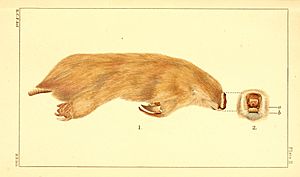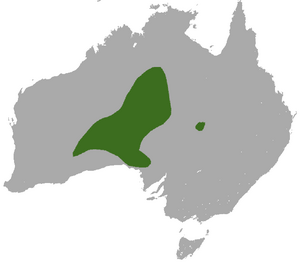Southern marsupial mole facts for kids
Quick facts for kids Southern marsupial mole |
|
|---|---|
 |
|
| Conservation status | |
| Scientific classification | |
| Genus: |
Notoryctes
|
| Species: |
typhlops
|
 |
|
| Southern marsupial mole range | |
The southern marsupial mole (Notoryctes typhlops), also called the itjaritjari, is a special mole-like marsupial. It lives in the sandy deserts of Australia. This amazing animal is perfectly built for digging underground. It has big, shovel-like front paws and soft, silky fur. This fur helps it "swim" through the sand easily. It also has very small eyes that it doesn't really need underground. The southern marsupial mole mostly eats earthworms and insect larvae.
Contents
Discovering the Southern Marsupial Mole
Even though Aboriginal people knew about the southern marsupial mole for thousands of years, scientists first studied it in 1888. A stockman named W. Coulthard found the first one. He saw some unusual tracks in the Northern Territory. Following them, he found the animal hiding under some grass.
He didn't know what it was, so he wrapped it up and sent it to E. C. Stirling. Stirling was the Director of the South Australian Museum. Because travel was hard back then, the mole arrived in bad shape. Stirling couldn't find its pouch or special bones. So, he first thought it wasn't a marsupial.
In the 1800s, scientists thought marsupials and other mammals (called eutherians) came from the same ancient animal. They were looking for a living animal that would be a "missing link." The marsupial mole looked a lot like the golden moles from Africa. Some scientists thought they were related and that they had found their proof. But this was wrong. Later, when better-preserved moles were found, it was clear they had a marsupial pouch. This showed they were indeed marsupials.
Marsupial Mole Family Tree
The family of marsupial moles, called Notoryctidae, doesn't have many fossils. But we do have evidence of an older type of marsupial mole, Yalkaparidon. Its fossils were found in rocks from the early Miocene period. These were discovered at the Riversleigh site in northern Australia.
Scientists have debated where marsupial moles fit in the animal family tree. This is because they look so unique. Also, they share many traits with other marsupials. However, recent studies of their DNA show something interesting. Marsupial moles are not closely related to any other marsupial families. Because of this, they now have their own special group, called Notoryctemorphia.
DNA evidence also suggests that marsupial moles separated from other marsupials about 64 million years ago. At that time, South America, Antarctica, and Australia were still connected. But the marsupial moles developed in Australia for at least 40-50 million years. The Riversleigh fossils suggest that Notoryctes was already good at digging. It probably lived in the rainforests that covered much of Australia back then. The land became much drier at the end of the Tertiary period. This change likely helped the marsupial mole become the super-specialized digger we see today. It was digging long before the Australian deserts even existed!
What Southern Marsupial Moles Look Like
The southern marsupial mole is a small animal. Its head and body are usually between 121 and 159 millimeters (about 5 to 6 inches) long. Its tail is short, about 21–26 millimeters (less than an inch). It weighs between 40 and 70 grams (about 1.4 to 2.5 ounces). Its body is covered in short, thick, silky fur. The fur is usually pale cream to white. Sometimes, it looks reddish-brown because of iron in the soil.
It has a light brownish-pink nose and mouth. It doesn't have whiskers (vibrissae). Its head blends right into its body, so it doesn't have a clear neck. Its legs are short and strong. The third and fourth toes on its front paws have big, spade-like claws. These are perfect for digging!
The skin on its nose and the back of its tail is tough and has no fur. It doesn't have outside eyes, and the nerve that connects eyes to the brain is missing. But it does have a colored spot where its eyes should be. This is probably a leftover part of its retina. It has well-developed tear glands and a special organ called Jacobson's organ. Scientists think the tear glands help keep its nose moist.
Its ear openings are covered with fur, and it doesn't have outer ear flaps. Its nostrils are small vertical slits right below its shield-like nose. The mole's brain is thought to be very simple. However, the parts of its brain that handle smell are very well developed. This means its sense of smell is super important. It helps the mole find its way and food in a dark, underground world. Its middle ear seems to be good at hearing low-frequency sounds.
How They Are Adapted
The southern marsupial mole is like other digging animals. It has a body temperature that can change a lot, from 15-30°C (59-86°F). It doesn't have a very low resting metabolism. But digging uses a lot of energy, about 60 times more than walking. Since it lives underground, where temperatures are cooler, it doesn't need special ways to deal with desert heat. We don't know if it drinks water. But because rain is rare, it probably doesn't need to.
Where Southern Marsupial Moles Live
We don't know much about where southern marsupial moles live. Most information comes from scattered sightings. They are often found in sandy dunes or flat areas. These places usually have spinifex grass. Their home seems to be limited to soft sand. They cannot dig through harder ground.
While we don't know their exact range, sightings and museum records show they live in the central sandy deserts. These areas are in Western Australia, northern South Australia, and the Northern Territory. Recent studies also suggest they live in the Great Victoria Desert and Gibson Desert.
Southern Marsupial Mole Behavior
We know very little about the behavior of marsupial moles. This is because few studies have been done in the wild. Also, moles kept in captivity usually don't live longer than about a month.
Moving Above Ground
Sometimes, these moles come to the surface. People have found their tracks. Most signs show they don't do this often. They usually move only a few meters before digging back down. But sometimes, many tracks are found. This suggests one or more moles moved above ground for several hours. Aboriginal people say marsupial moles can surface at any time of day. But they seem to prefer to come out after rain and during cooler seasons.
Moles in captivity have been seen eating above ground. Then they go back underground to sleep. Sometimes, they suddenly "faint" on the surface. They won't wake up for several hours unless someone disturbs them.
When above ground, they move in a wavy way. They use their strong front paws to pull their body forward. Their back legs push them along. Their front paws move together with the opposite back leg. Moles move quickly but not very fast on the surface. One person said it was like a "Volkswagen Beetle heaving its way through the sand."
Digging Behavior
When digging, the southern marsupial mole doesn't make tunnels that stay open. The sand behind it caves in and fills the tunnel as it moves. Because of this, its digging style is like "swimming through the sand." The only way to spot its tunnels is by a small oval shape of loose sand.
It spends most of its active time 20-100 cm (about 8-40 inches) below the surface. It tunnels horizontally or at shallow angles. But sometimes, for no clear reason, it suddenly digs straight down. It can go as deep as 2.5 meters (about 8 feet)!
Most of its food is probably found about 50 cm (20 inches) deep. The temperature at these depths changes a lot. It can be less than 15°C (59°F) in winter and over 35°C (95°F) in summer. One captive mole shivered when the temperature dropped below 16°C (61°F). This suggests moles can choose their temperature by digging to different depths.
What They Eat
We don't know much about what southern marsupial moles eat. All information comes from studying the stomach contents of preserved moles. Also, observations of moles in captivity help. All signs point to the mole being mainly an insectivore. This means it eats insects. It prefers insect eggs, larvae, and pupae over adult insects.
Based on captive moles, one of their favorite foods is beetle larvae. Especially the larvae of scarab beetles. Digging uses a lot of energy. So, it seems unlikely the mole searches for food by digging everywhere. It probably finds its food within insect nests. It has also been seen eating adult insects, seeds, and small lizards. Below the desert sands, the marsupial mole searches for burrowing insects and small reptiles. Instead of building a tunnel, it "swims" through the ground, letting the sand collapse behind it.
Social Life
We know very little about how these animals live together or reproduce. But all signs suggest they live a solitary life. There are no signs of large burrows where more than one mole might meet. We don't know how males find females. But it's thought they use their amazing sense of smell.
The mole's middle ear seems built to hear low-frequency sounds. Moles also make high-pitched sounds when handled. This suggests they might use these sounds to talk to each other. Low-frequency sounds travel more easily underground.
Marsupial Moles and People
Aboriginal people have known about the southern marsupial mole for thousands of years. It was part of their stories and beliefs. It was linked to special places and dreaming trails, like Uluru. Aboriginal people felt a connection to this harmless creature. They only ate it when food was very scarce.
Aboriginal people are very good at tracking animals. They often help scientists learn tracking skills and find moles. Their help is very important for learning about the mole's home and behavior.
Old records suggest the southern marsupial mole was quite common in the late 1800s and early 1900s. There was a big trade in marsupial mole skins in the Flike River area between 1900 and 1920. Many Aboriginal people came to trading posts with 5-6 skins each. They traded them for food and other goods. It's thought that hundreds to thousands of skins were traded. This shows the mole was common back then.
Protecting the Southern Marsupial Mole
We know so little about the southern marsupial mole. This makes it hard to know its exact numbers and how they have changed. But some signs suggest their numbers are going down. It's hard to tell for sure, but there are reasons to worry.
About 90% of medium-sized marsupials in dry Australia are now threatened. This is mostly because of cat and fox predation. A recent study found marsupial mole remains in 5% of cat and fox droppings. Moles are also sensitive to changes in their food supply. This can happen because of different fire patterns and too many plant-eating animals.
The southern marsupial mole is currently listed as endangered by the IUCN. Efforts to protect this species focus on a few things. We need to keep a healthy number of moles to understand them better. We also need to do more studies in the wild. These studies will help us track where they live and how many there are, with the help of Aboriginal people.
Images for kids
See also
 In Spanish: Topo marsupial meridional para niños
In Spanish: Topo marsupial meridional para niños




